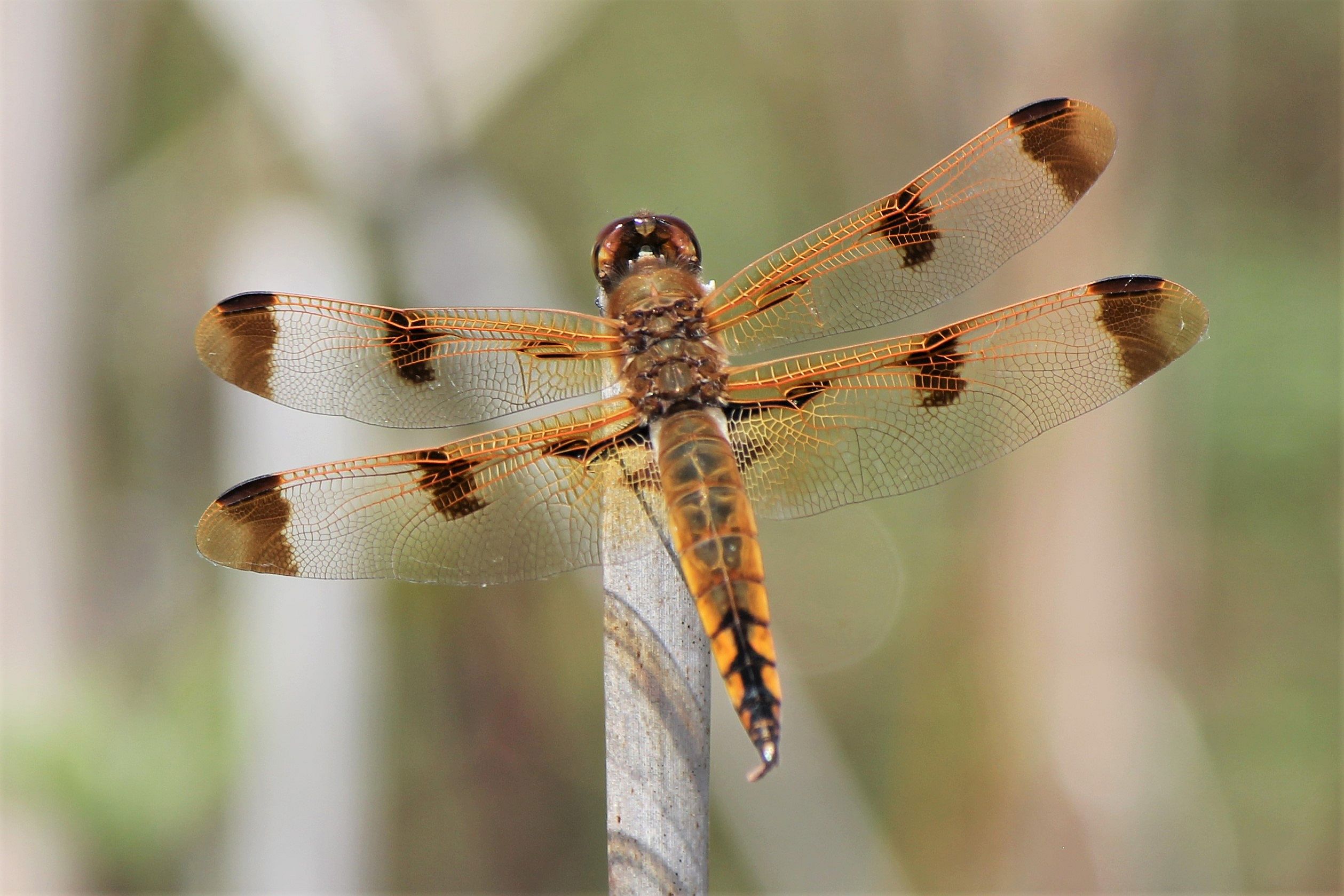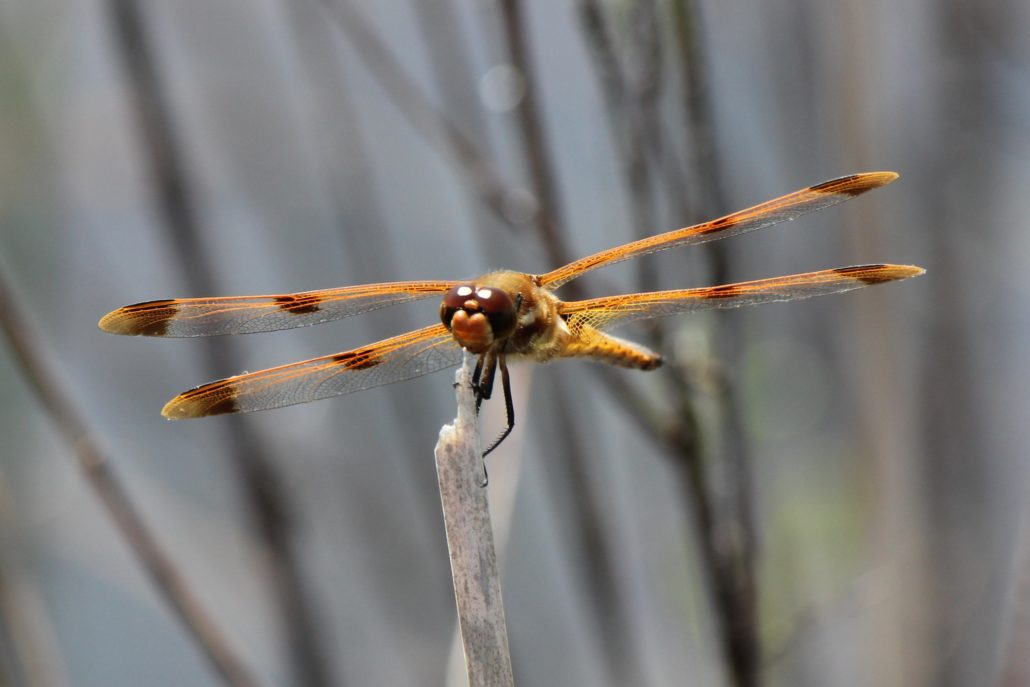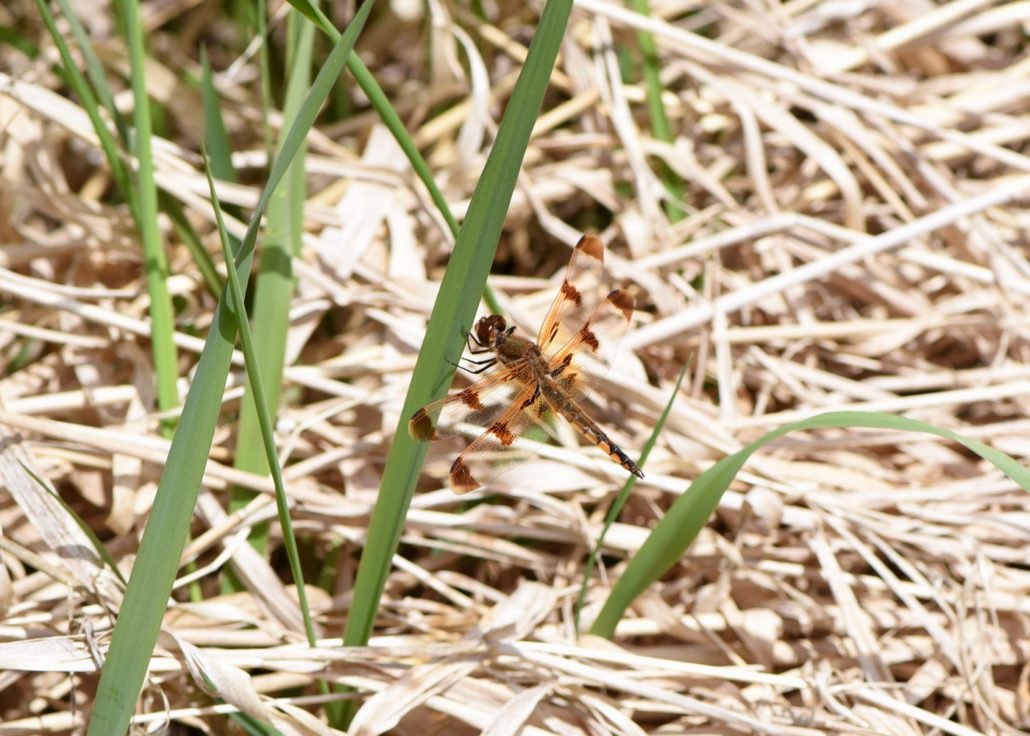
Painted Skimmer Dragonflies
Greetings, BugFans,
The BugLady got an email from BugFan Freda the other day saying that she had located two Painted Skimmers at a nearby natural area, and she’d be glad to show the BugLady where they were (and to wear footgear that could get wet or muddy, which pretty much describes all of the BugLady’s shoes). The BugLady is 95% sure that she saw the rear end of one of the skimmers while she and Freda were poking around – she flushed a dragonfly that was the right size and shape, but it popped up and over some cattails and kept going. Thanks for the use of your pictures, Freda.
Painted Skimmers are in the Skimmer family Libellulidae, which contains many of our more common and more colorful dragonflies, and they’re in the genus Libellula – large, sturdy, showy dragonflies, often with dramatically-patterned wings, that are often referred to as the King skimmers. King skimmers have appeared in these pages before https://uwm.edu/field-station/closed-for-june-spectacular-summer-dragonflies/, https://uwm.edu/field-station/four-spotted-skimmer/, and https://uwm.edu/field-station/slaty-skimmer-dragonfly/ (Chalk-fronted Corporals are sometimes included in the group, too https://uwm.edu/field-station/chalk-fronted-corporal-dragonfly/).
They look like a dragonfly that was put together by a committee. Their wing spots are similar to, but fainter than, those of a Halloween Pennant (all the Painted Skimmer write-ups say “see also: Halloween Pennant” https://bugguide.net/node/view/1996897/bgimage), and their abdomen looks a lot like that of a Four-spotted Skimmer, an early-flying dragonfly whose wing spots are much smaller https://bugguide.net/node/view/1220037/bgimage. Female Painted Skimmers https://bugguide.net/node/view/1664464/bgimage are duller in color, with wider abdomens than males https://bugguide.net/node/view/1665876/bgimage. They often look golden in flight. There are many wonderful photos of Painted Skimmers online, but not much in the way of biographies.

Painted Skimmers (Libellula semifasciata) occur only rarely in Wisconsin (they’re a “Most Wanted” species here). They’re on dragonfly checklists from Texas to Florida to Maine to Ontario, becoming rarer as you travel farther north, and they’re at the edge of their range here in Wisconsin. They’re one of the fifteen-or-so species of North American Odonates that migrate (out of our 450-ish species), moving both north and south along the Atlantic Coast as well as inland. They arrive in the north early (one source said that many of the first arrivals are mature males); they often stay just long enough to get people excited (birders will sympathize); and they’re more numerous some years than others. According to the Wisconsin Odonata Survey database https://wiatri.net/inventory/odonata/, they’ve been recorded in only seven of the years since 2000, and 2022 is the only year that they’ve been seen in multiple locations (five so far). When the Bug Lady was looking into that, she found this handy list http://texasento.net/migration.htm.
One source described them as widespread and relatively common but not often seen, due to their early flight period (they usually show up in June and July, so the influx of Painted Skimmers in 2022 is early) and to their habitat preferences. They frequent shallow, plant-filled, marshy, woodland ponds, pools, seasonal puddles, and sometimes bogs and slow-moving streams, but they may hunt for food far from water. Like all dragonflies, their aquatic young (naiads) (“nymphs,” if you must, but never “larvae”) eat the small invertebrates that they find next to them below the water’s surface, and the adults feed on flying insects. Painted Skimmer dragonflies perch on twigs and fly out to “hawk” small insects.

The Dragonflies of Northern Virginia website calls them both less aggressive and more wary than other King skimmers.
Males patrol territories and watch for females from perches on twigs or grass tips three to six feet above the water. They mate (briefly) in mid-air, he releases her, and Paulson, in Dragonflies and Damselflies of the East, tells us that “Females oviposit in low flight by vigorous and well-spaced tapping and moving some distance between groups of a few taps.” Males often patrol as she oviposits in order to protect her (and his genetic material) from being nabbed by rival males.
In her search for information, the BugLady turned up the comment on the Northern Virginia Dragonfly website (on two different pages) that “Some dragonflies have partially translucent abdomens (Painted Skimmers) and many others have dark wing patches at the base of their wings (saddlebags and pennants) – both may be anatomical adaptations to absorbing sunlight and channeling that heat to their organs and wing muscles.” She suspects that means that the dragonfly’s cuticle allows some light to pass through, and not that you can hold up a Painted Skimmer and see daylight through it. She couldn’t find any other sources to back that up.
Go outside – keep your eyes peeled. Things are popping!
Kate Redmond, The BugLady
Bug of the Week archives:
http://uwm.edu/field-station/category/bug-of-the-week/
